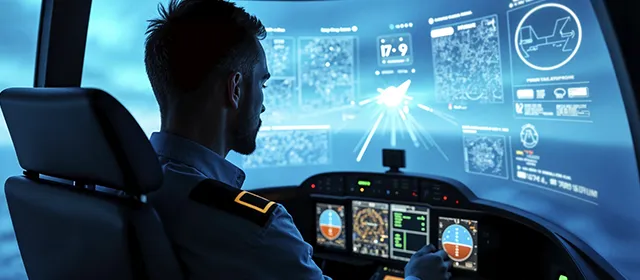In the high-stakes world of aviation, accuracy and reliability are non-negotiable—and that’s where aircraft sensors come in. These critical components are the unsung heroes behind safe flights, efficient fuel use, real-time diagnostics, and advanced automation. As airlines and aircraft manufacturers embrace smarter technologies, the demand for high-performance sensors is soaring. This is ultimately fueling the expansion of the aircraft sensors market.
The global aircraft sensors market is experiencing rapid growth, driven by trends like predictive maintenance, electric aviation, and digital transformation. Let’s take a detailed look at the top 10 companies that are making a significant impact in this space.
Market Outlook
The aircraft sensors market is expected to exceed $6,642.1 million by 2032, according to Kings Research. This growth is mainly driven by:
- Increasing demand for predictive maintenance
- Adoption of smart and wireless sensor technologies
- Expansion in UAVs and electric aircraft
North America continues to dominate the market, but rapid growth in Asia-Pacific, especially in China and India, is reshaping the global landscape.
Top 10 Companies Leading the Aircraft Sensors Market
With growing demand for fuel efficiency, predictive maintenance, and automation, the global aircraft sensors market is booming. Listed below are the major companies contributing to this notable market growth.
1. Honeywell International Inc.
Honeywell is a major player in aerospace innovation and a top provider of advanced aircraft sensors. The company offers a broad portfolio including pressure sensors, inertial measurement units (IMUs), air data sensors, and more. Honeywell's sensors are widely used in both commercial and defense aircraft.
Why it stands out:
Honeywell is at the forefront of digital transformation in the aircraft sensors market. Their sensors are not only accurate but also integrated with IoT platforms to enable real-time data analysis and predictive maintenance. A recent collaboration with Lilium on electric air taxis further showcases Honeywell's forward-looking approach.
2. RTX (formerly Raytheon Technologies)
RTX, which includes legacy companies like Collins Aerospace, is a key player in the aerospace and defense sectors. Their aircraft sensors are critical components in systems for avionics, propulsion, and environmental control.
Why it stands out: RTX is driving innovation with smart sensor systems that enhance situational awareness, flight safety, and operational efficiency. Their work on next-generation radar and environmental sensors highlights their commitment to future-ready aviation technology.
Known for its powerful jet engines, GE also plays a vital role in the aircraft sensor market expansion. The company integrates a wide array of sensors into its engines to monitor parameters like temperature, pressure, and vibrations.
Why it stands out: GE combines sensor hardware with analytics software to deliver predictive maintenance insights. Their holistic approach ensures better engine health monitoring and reduced downtime, which translates to lower costs and improved safety for airlines.
Curtiss-Wright has a rich heritage in aviation and continues to serve the industry with high-performance sensor solutions. Their products are widely used for engine control, flight data monitoring, and environmental systems.
Why it stands out: Curtiss-Wright specializes in rugged sensors built for extreme environments. Their solutions are trusted in both commercial aviation and military applications, and they consistently innovate through acquisitions and in-house development.
5. Safran Group
Headquartered in France, Safran is a major global supplier of aircraft systems and equipment. The company offers a wide range of sensors for aircraft propulsion, electrical systems, and avionics.
Why it stands out: Safran is deeply involved in the development of sustainable aviation. Their sensor technology is helping power hybrid-electric aircraft and other eco-friendly aviation solutions. The company is also working on next-gen inertial navigation systems for improved flight accuracy.
TE Connectivity specializes in sensors and connectors that operate in harsh environments, making them ideal for aerospace applications. Their portfolio includes sensors for pressure, temperature, humidity, and position monitoring.
Why it stands out: TE Connectivity is known for innovation in miniaturized and smart sensors. These sensors are often integrated with aircraft systems to provide real-time monitoring and diagnostics, improving both safety and efficiency.
Through its Parker Aerospace division, Parker Hannifin offers advanced solutions for flight control, fuel, and hydraulic systems. Many of these systems rely heavily on sensors to ensure optimal performance.
Why it stands out: Parker Hannifin's sensors support real-time monitoring and control of mission-critical systems. The company is heavily invested in improving flight safety and reducing emissions through smarter sensor technologies.
8. AMETEK, Inc.
AMETEK provides high-precision sensors and instrumentation solutions for a variety of industries, including aerospace. Their products are used to monitor everything from fuel flow to structural integrity.
Why it stands out: AMETEK's sensors are known for their reliability and accuracy. The company focuses on continuous R&D to meet the growing demands of the aerospace sector, particularly in high-performance military and commercial aircraft.
9. Thales Group
Thales is a global technology leader in aerospace, defense, and transportation. The company provides a broad range of sensor solutions used in avionics, radar, and navigation systems.
Why it stands out: Thales is exploring the use of AI in sensor systems to enhance aircraft autonomy and environmental sensing. Their sensors are used in major commercial programs with Airbus and other OEMs.
10. PCB Piezotronics, Inc.
A leader in piezoelectric sensor technology, PCB Piezotronics offers solutions for measuring vibration, pressure, and acceleration. These sensors are crucial for engine monitoring, structural health, and flight testing.
Why it stands out: PCB Piezotronics is known for its highly sensitive and reliable sensors, which are widely used in both OEM production and MRO (maintenance, repair, and overhaul) settings.
Final Thoughts
As the aircraft sensors market continues to evolve, the importance of reliable and intelligent sensor systems becomes even more critical. From monitoring engine conditions to supporting autonomous flight, these devices are central to operational excellence and passenger safety.
The top 10 aircraft sensor companies highlighted in this blog are not just responding to industry demands—they’re setting new standards. With ongoing investments in R&D, AI integration, and eco-friendly solutions, these firms are helping the aerospace sector navigate a future that is smarter, safer, and more sustainable.


